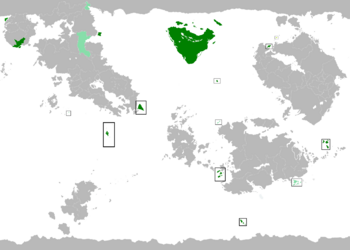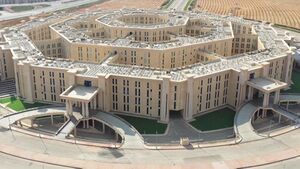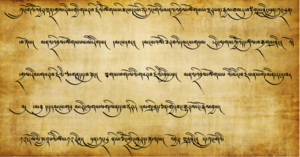Kiravia: Difference between revisions
mNo edit summary |
m Text replacement - "Aboriginal Kiravite" to "Urom" |
||
| Line 31: | Line 31: | ||
* 11.4% [[Celtic]] | * 11.4% [[Celtic]] | ||
* 4.5% [[Kiravia#Cultural_groups|Minorities]] | * 4.5% [[Kiravia#Cultural_groups|Minorities]] | ||
* 2.1% [[ | * 2.1% [[Uroms|Urom]] | ||
* 5% Other | * 5% Other | ||
|religion = | |religion = | ||
| Line 119: | Line 119: | ||
==Society and Culture== | ==Society and Culture== | ||
{{User:Kir/Template}} | {{User:Kir/Template}} | ||
Kiravia has a unique and multifarious society, quite unlike any other in the world and with a great deal of internal diversity. Kiravian culture derives primarily from the ancient heritage of [[Coscivian civilisation|Coscivian culture]], and a supermajority of Kiravians consider themselves to be Coscivians. Kiravian society has been further enriched by the contributions of [[ | Kiravia has a unique and multifarious society, quite unlike any other in the world and with a great deal of internal diversity. Kiravian culture derives primarily from the ancient heritage of [[Coscivian civilisation|Coscivian culture]], and a supermajority of Kiravians consider themselves to be Coscivians. Kiravian society has been further enriched by the contributions of [[Uroms|Aboriginal]] and [[Celtic-Kiravians|Celtic]] peoples, as well as by influences brought from further abroad by extensive overseas trading networks. | ||
Due to its long history as an independent civilisation and limited adoption of Occidental norms beyond the pervasive acceptance of Christianity (''see [[Kiravia#Religion|Religion]] below''), Kiravia is generally considered to be outside the scope of the [[Occidental world]]. | Due to its long history as an independent civilisation and limited adoption of Occidental norms beyond the pervasive acceptance of Christianity (''see [[Kiravia#Religion|Religion]] below''), Kiravia is generally considered to be outside the scope of the [[Occidental world]]. | ||
Revision as of 14:01, 1 November 2022
Kiravian Federacy ꅆ꒼ ꑓꐔꈕ Kiravix Rektārka | |
|---|---|
Motto: Cia Aslovniūn ūos Lōmin Go Forth and Begin | |
 Kiravian Federacy in forest green ○ Kiravian Collectivity in mint green Disputed claims in lime green | |
| Capital | Kartika |
| Largest city | Valēka |
| Official languages | Kiravic Coscivian |
| Ethnic groups |
|
| Demonym(s) | Kiravian |
| Government | Crowned republic Asymmetric federal republic |
• Emperor | Marble Emperor |
| Adheritus Ilkaśvar | |
| Legislature | Federal Stanora |
| Population | |
• Census | 1,147,615,225 |
| GDP (nominal) | estimate |
• Total | $52,348,709,068,622 |
• Per capita | $45,615.21 |
| Currency | Saar (KFS) |
| Time zone | Valēka Standard Time |
| Driving side | left |
| Calling code | +47 |
| Internet TLD | .kr |
Kiravia (Coscivian: Kiravix Rektārka ), officially the Kiravian Federacy, is a pluricontinental political union (a federacy) centred on the island continent of Great Kirav. The heartland of Coscivian civilisation in Ixnay, over the past several centuries Kiravia has gradually evolved from a reclusive and isolated backwater nation into a major economic and strategic power, with strong influence in the rest of Kiroborea, the Odoneru Basin, and Crona.
Geography
For further information on this topic, see Great Kirav.
Kiravia is a pluricontinental union centred on the island continent of Great Kirav and incorporating lands in Crona (Æonara, Atrassica), Levantia (Suderavia, New Ardmore), and Sarpedon (Sydona, Melian Isles) as integral components of its territory, as well as island possessions scattered about the world's oceans.
Politics and Governance
The Kiravian Federacy is a crowned republic - the government is instituted in the name of the Coscivian Emperor, with whom sovereignty ultimately rests, but is entirely republican in form and function. It is also an asymmetric federation (a federacy) in which the powers and responsibilities of governance are shared between the federal government and the governments of the subnational states, territories, and other units, known generically as federal subjects.
Constitutional framework
See Constitutional history of Kiravia.



The structure of the Kiravian political system is laid out in the Constitution of the Kiravian Federacy, also referred to as the 'Fundamental Statute' (Livnifîlon). Constitutional authority is distributed among several organs of government, each with certain institutional checks against the powers of the others. Executive power is vested in the indirectly-elected Prime Executive and the appointed Executive College, responsible for the administration of the Government, enforcement of laws, and conduct of military and diplomatic affairs. The PE and Executive College can promulgate secondary legislation and (within certain parameters) primary legislation through various forms of decrees. The Federal Stanora is a representative and deliberative body elected by Kiravian citizens, with seats distributed among the federal subjects. The Stanora enacts primary legislation, authorises expenditure, and raises revenue. It also exercises supervisory powers over government agencies. The Federal Consistory serves as the nation's constitutional court, adjudicating disputes among the other organs of government and reviewing the constitutionality of their acts, as well adjudicating disputes among the federal subjects. The Federal Council, elected by the governments of the Kiravian states, is primarily an accountability body responsible for conducting audits and resolving charges of official misconduct by officials of other branches. It also possesses certain powers relating to the constitutional amendment process, appointments, and the currency.
Federal structure
See Kiravian federalism.
The Kiravian Federacy is an asymmetric federation, composed of units known generically as "federal subjects" or "provinces". Provinces belong to several different classes of constitutional status, entailing different degrees and manners of autonomy, and different rights and responsibilities with respect to the federal political process.
Kiravian domestic policy is very decentralised. Responsibility for the low politics of economic development and regulation, social affairs, public services, law and order, and public works rests primarily with the provincial governments, which in turn delegate many matters down to more local levels of government, such as amtra or raīon and municipalities.
Political landscape
Law
Foreign relations
In the context of modern international relations, Kiravia has traditionally behaved as an offshore balancer, acting to prevent or undermine continental hegemony by any one power over Levantia, Sarpedon, or Crona, and to maintain a stable and favourable balance of power on the global stage. In the decades following the Restoration, it has become common to describe the Federacy's geopolitical position as a "lonely medium" (sambix imvikor), implying that it has few close allies but also few clear adversaries.
The Federacy's closest allies are the Cape, a former Kiravian colony that became independent in 1901, and Faneria, the Kiravian mainland's closest geographic neighbour, to which it has extensive historical and cultural ties. Trilateral coöperation between these three countries has been institutionalised as the League of Free Republics. Kiravia also enjoys strong relations with Paulastra (also of Kiravian colonial heritage and with robust commercial ties) and Fiannria. Throughout the early modern period, a Kiravia and Burgundie were locked in a fierce rivalry for military, mercantile, and colonial supremacy, escalating at several points into a series of armed conflicts known as the Kiro-Burgoignesc Wars. This rivalry became irrelevant by the early 20th century, and there is now considerable Kiro-Burgoignesc coöperation in spheres such as trade, environmental monitoring, and maritime safety, though relations have been at times complicated by the disputed territorial status of Wintergen.
The Kiravian Federacy is a member of the League of Nations and a permanent member of the League of Nations Security Council. It is also a founding member of SNOWPEC and the Multilateral Coöperation Council.
Society and Culture
This page is currently undergoing major reconstruction in accordance with broader lore changes. |
Kiravia has a unique and multifarious society, quite unlike any other in the world and with a great deal of internal diversity. Kiravian culture derives primarily from the ancient heritage of Coscivian culture, and a supermajority of Kiravians consider themselves to be Coscivians. Kiravian society has been further enriched by the contributions of Aboriginal and Celtic peoples, as well as by influences brought from further abroad by extensive overseas trading networks.
Due to its long history as an independent civilisation and limited adoption of Occidental norms beyond the pervasive acceptance of Christianity (see Religion below), Kiravia is generally considered to be outside the scope of the Occidental world.
[Tuva in here somewhere]
The strong bonds of tuva and the later and shallower onset of nationalism have resulted in Kiravians having a thick web of nesting and overlapping group identities and communal affiliations.
Cultural Groups
For public policy purposes, Kiravian governments classify the numerous ethno-social groups into X broad categories:
- Coscivians (Koskidéruv) - Subject peoples of the Coscivian Emperor from before the Continental War who keep the Four Precepts and the Four Rites and are self-identified and recognised as such, as well as peoples later declared Coscivians by the Emperor's stewards.
- Minorities (Śudraplānonya) - Civilized (that is, non-tribal) peoples native to the territory the Kiravian Federacy who were not (as bodies corporate) direct subjects of the Emperor before the Continental War, have a substantial history of cultural and political autonomy, and maintain a separate identity from Coscivians.
- Celts - Non-Coscivians of Celtic ethnic and linguistic background
- National Minorities - Meltotes and native Sydonans.
- Scheduled Minorities - Non-tribal Boreal peoples listed in the Constitution - Rhūniks, Érhuans, Sikuryans, Skithanawites, Ainarom, Ekxõ, Wastani, Caoi.
- Urom - Tribally-organised peoples native to Great Kirav who held the status of umpéa under Imperial law.
- Overseas Minorities - Non-Coscivian, non-Celtic peoples native to the Overseas Regions and Sarolasta.
Statistical demography
Kiravia has a population of just under 1.15 billion. The larger population and higher population density of Great Kirav (where the majority of this population is located) compared to other temperate areas of commensurate size is attributed primarily to a higher base figure made possible by early cultivation of the potato.
As of 21209 the crude birth rate was 14.1‰ and crude death rate 8.2‰, yielding a natural increase rate of +5.9.
Language

Kiravia is a multilingual nation and a global hotspot for linguistic diversity. Challenging terrain in may parts of the country, tuva, and a decentralised political environment have contributed to the continued vitality of many smaller speech communities. Most living languages native to Great Kirav belong to the Cosco-Adratic or Elutic-Intheric families, though there are a few smaller families of tribal languages and isolates that defy classification. The two most important languages in Kiravia are Kiravic Coscivian and High Coscivian. Kiravic is the language of the Kir people and the prevailing language across most of northern Great Kirav. Due to its large speaker base and widespread use as an inter-ethnic lingua franca, Kiravic has become the working language of the federal government and the main language used in the business world. High Coscivian is the classical language of Coscivian civilisation, with perhaps the longest continuing literary tradition of any language, with original compositions in High Coscivian still being published today. It is a sacred language in several Coscivian religions and the liturgical language of the Coscivian Rite church. Although under pressure from Kiravic in some disciplines, High Coscivian remains the predominant language of higher education and academic discourse, the main language of scientific publications, and a source of learned borrowings into other Kiravian languages. Largely replaced by Kiravic and other modern languages for administrative purposes from the late 19th century AD on, High Coscivian is still commonly used in law and the judiciary in many states, and for ceremonial purposes.
Major regional and ethnic languages spoken in Kiravia are Gaelic, Southern Coscivian (spoken in South Kirav), West Coast Marine Coscivian (spoken in easterly inland areas), Kalverthan Coscivian (spoken in the Baylands), Taństan Coscivian (in Andera and by the Taństan diaspora, Austral Coscivian (in Sydona), Antaric Coscivian, Æran-Kaltan Coscivian, and Serradan Coscivian.
Several Austronesian languages are spoken in Sarolasta and Seváronsa, the isolate Melote language in the Melian Isles, and, numerous indigenous Cronite languages in Kiravia's Cronan territories.
Religion
Kiravia is a deeply religious nation. Notions of holiness and reverence are rooted deep in its cultural traditions, far beyond the depth of documentary history, and are of great importance in the lives of most Kiravians. A significant minority of Kiravians report participating in religious devotions other than personal prayer on a daily basis.
The majority of Kiravians are Christians, with a plurality adhering to the Catholic Church and mainly worshipping in it Coscivian Rite, followed by the Coscivian Orthodox Church and Insular Apostolic Church. The Christianisation of Kiravia occurred in three waves, first in the South in the [CENTURY] AD, giving rise to the Coscivian particular church, and next in the Northeast and Kilikas Basin in the [6th century?] AD, giving rise to the Insular Apostolic Church. The West Coast was rapidly evangelised by the Catholic Church during the Xth century. In addition to the three major apostolic churches, a smaller but significant share of Kiravians belong to other Christian denominations, including Protestant ecclesial communities (mainly of Wesleyan and Lutheran persuasions), and a colourful collection of small native denominations referred to as Kiravian Sectarians.
The two main religious minorities in Kiravia are followers of Coscivian-origin religions and Muslims. Surveys of religious identification tend to misrepresent the extent to which practice of Coscivian religions such as Iduanism, Sarostivism, and Ruricanism continues in modern Kiravia, as many Kiravian Christians and Muslims engage in substantial syncretism with these older traditions in their spirituality, or at least maintain some connexion to rituals from these religions as part of their cultural heritage and community life. Islam arrived in Kiravia during the Xth century AD, carried by seaborne trade with Audonia, and spread mainly in the South. Kiravian Islam spans several different theological schools and social communities.
Common features of religious observance in Kiravia that cut broadly across different traditions and denominations include some form of prayer for the dead (likely absorbed from traditions of ancestor worship), association of the Moon and lunar imagery with the sacred, and an important role for ascetic orders and monasticism.
Arts
Sport and Recreation
Economy

Kiravia has a large, developed economy in gradual but steady transition from an export-oriented, hard state-capitalist economic model toward a more 'mature' ordoliberal market-driven one buoyed by burgeoning domestic consumption. It has the largest national economy in Kiroborea, the third-largest by nominal GDP in Ixnay, and the Xth largest by GDP (PPP). A major trading power, it is among the top importers and exporters, with the largest effective merchant marine.[1]
Although currently ranked as Ixnay's third largest economy by gross domestic product, Kiravia faces considerable challenges with regard to global competitiveness in the postmodern world economy. In addition to energy insecurity and uneven regional development as discussed below, Reserve Bank of Kirav identifies a comparatively small free trade area, lack of a competitive edge in the culture industry and increasingly design-focused digital marketplace, relatively low intake of valuable foreign knowledge workers, moderate corruption and the influence of organised crime, and a less-than-seamless domestic common market as major disadvantages vis-à-vis the near-peer Urcean and Caphirian economies and highly developed, innovation-heavy economies such as Burgundie and Alstin.
Sectors
Agriculture and Forestry
Great Kirav hosts the northernmost significant agricultural sector, as well as the vast majority of cultivated land between the 60th and 65th parallels north. However, the most productive agricultural regions per cultivated hectare are in warmer, more southerly areas such as South Kirav and the Middle Belt, the antipodean Sydona Islands, and other overseas possessions with more conducive growing conditions.
Kiravian agriculture is generously subsidised by the federal and provincial governments alike, both directly through dedicated farm aid bills and incentive programmes, and indirectly through various rural development, regional convergence, ethnic/tribal development, and sustainability funds under the purview of the Executive for Development & Regional Balance.
[Kérmipelakrāsta] [Kelvakrāsta]
Vast timber reserves in Great Kirav, Koskenkorva, and the Cusinaut colonies are a major natural resource, and historically contributed to the rise of Kiravian naval power. Kiravia is the largest producer and second-largest exporter of softwood timber in Ixnay. Softwood timber is also a crucial raw material supplied to domestic the domestic pulp-and-paper, upholstery, and pine flannel industries.
Industry
The main industrial regions were the north-eastern seaboard, the Lake Belt, the Aterandic Piedmont, and the Leeward Front in Great Kirav, as well as the Sydona Islands. Æonara underwent rapid state-driven industrialisation during the Sunderance.
Trade and Services
A precocious revolution in seafaring technology and the consolidation of trans-oceanic trade networks was spurred by the lucrative Kiravian ice trade, in which Kiravia fed the ample demand for water ice in the calid climes of Sarpedon and South Levantia.
High technology and Digital economy
Both the Kiravian Union and Kiravian Remnant were pioneers of computing technology, and the reunified Kiravian high-technology sector established an early lead in many facets of the industry.
Regional Disparities
See also: Three Kiravs Model
Post-Kirosocialist (and indeed, pre-Kirosocialist) patterns of economic growth and development, investment, and standards of living have been geographically uneven across Kiravian territory. Coastal metropolitan areas, such as those surrounding Valēka, Saar-Silverda, Primóra, and Béyasar, are well-integrated into the global economy, are major growth engines for the country as a whole, and enjoy access to world-class goods and services. In contrast, many inland, rural, and micropolitan areas have been adversely impacted by liberalisation and in many cases have stagnated since the end of Kirosocialism. South Kirav and many high-altitude and/or high-latitude regions of the country face persistent development challenges that predate Kirosocialism and may involve weak or extractive social institutions and geographic constraints.
Energy

Kiravia is the largest[citation needed] energy consumer in Ixnay and the leading energy importer. The vast energy demand generated by its large population, advanced economy, and cool climate greatly outstrip domestic supply. Maintaining a reliable energy supply and reasonable prices is a perennial policy concern at the federal level, and a great deal of public expenditure has been dedicated to energy subsidies, energy research, the development of domestic energy sources, and the upkeep of good trade relations with major energy-exporting countries.
Kiravia is a world leader in nuclear research (both civilian and military) and has invested extensively in the development of nuclear power to meet its staggering energy needs.
Major fossil fuel suppliers to the Kiravian market include Cartadania and other nations.
Peat is plentiful across many parts of Great Kirav, particularly the upper and upper-middle latitudes, where it is commonly used as a household fuel source, especially in rural areas. Kiravians traditionally harvested peat from nearby bogs themselves or purchased cut peat bricks or briquettes to be delivered to their homes, practices which continue today. There are also dozens of peat-fired power plants in Kiravia that feed into modern electrical power grids.
See Also
- ↑ If vessels flagged to both the Kiravian Federacy itself and its associated state of Pribraltar are counted together.

